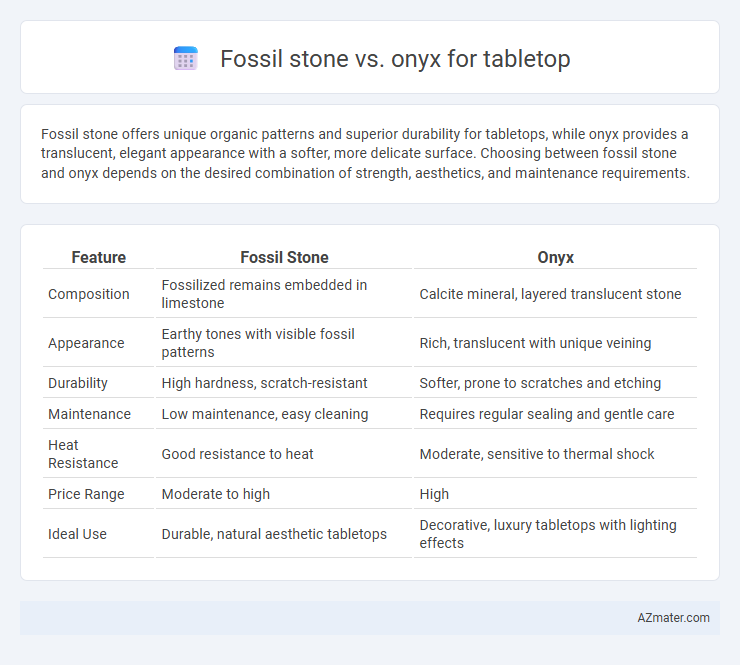Fossil stone offers unique organic patterns and superior durability for tabletops, while onyx provides a translucent, elegant appearance with a softer, more delicate surface. Choosing between fossil stone and onyx depends on the desired combination of strength, aesthetics, and maintenance requirements.
Table of Comparison
| Feature | Fossil Stone | Onyx |
|---|---|---|
| Composition | Fossilized remains embedded in limestone | Calcite mineral, layered translucent stone |
| Appearance | Earthy tones with visible fossil patterns | Rich, translucent with unique veining |
| Durability | High hardness, scratch-resistant | Softer, prone to scratches and etching |
| Maintenance | Low maintenance, easy cleaning | Requires regular sealing and gentle care |
| Heat Resistance | Good resistance to heat | Moderate, sensitive to thermal shock |
| Price Range | Moderate to high | High |
| Ideal Use | Durable, natural aesthetic tabletops | Decorative, luxury tabletops with lighting effects |
Introduction to Fossil Stone and Onyx Tabletop Options
Fossil stone tabletops showcase ancient marine life patterns embedded in natural limestone, offering unique, durable surfaces with distinctive fossilized textures. Onyx tabletops feature translucent, multicolored stone with striking veins, prized for its elegant appearance and ability to create dramatic backlit effects. Both materials provide exceptional aesthetic appeal and durability, making them popular choices for luxury tabletop options.
Origins and Formation: Fossil Stone vs. Onyx
Fossil stone originates from sedimentary rock embedded with ancient organic remains, formed over millions of years through the gradual accumulation and mineralization of biological material. Onyx is a variety of chalcedony, created through the layering of silica deposits in cold water environments, resulting in its distinct banded appearance. Both stones showcase unique geological histories, with fossil stone revealing historical life forms, while onyx displays intricate mineral growth processes.
Visual Appeal: Color, Pattern, and Texture Comparison
Fossil stone showcases intricate patterns of ancient marine life fossils embedded in a matrix of neutral beige and brown tones, creating a natural, earthy visual appeal with a tactile, slightly porous texture. Onyx offers a striking translucent quality with vibrant bands and swirls in colors ranging from creamy whites and honey tones to deep greens and reds, providing a polished, smooth surface ideal for luminous tabletops. The visual contrast between fossil stone's matte, organic motifs and onyx's glossy, dramatic veining allows for distinct aesthetic choices in luxury furniture design.
Durability and Longevity in Daily Use
Fossil stone offers high durability due to its dense composition and resistance to scratches and heat, making it ideal for heavy daily use on tabletops. Onyx, while visually striking with its translucent and polished surface, is softer and more prone to scratches and etching, requiring careful maintenance to preserve its longevity. For long-term durability and minimal wear, fossil stone outperforms onyx in resisting chips, stains, and surface damage in everyday environments.
Maintenance Requirements for Tabletop Surfaces
Fossil stone tabletops require sealing every 1 to 2 years to prevent staining due to their porous nature, while onyx surfaces demand more frequent sealing, often biannually, to maintain their polished appearance and avoid etching. Both materials should be cleaned with pH-neutral cleaners, but onyx is more susceptible to acid damage from common household substances like vinegar or lemon juice. Proper maintenance of fossil stone and onyx tabletops prolongs their durability and aesthetic appeal, with onyx requiring more careful handling to preserve its translucency and luster.
Cost Differences: Affordability and Investment Value
Fossil stone tabletops generally offer a more affordable option compared to the luxurious Onyx, making them a cost-effective choice for budget-conscious buyers. Onyx tabletops, prized for their translucent beauty and rarity, command a higher price that reflects their investment value and exclusivity. Choosing between the two depends on balancing the initial cost with long-term aesthetic appreciation and durability considerations.
Environmental Impact and Sustainability Factors
Fossil stone, often composed of compacted organic remains, has a lower environmental impact due to its natural formation process that involves minimal quarrying and energy consumption. Onyx, a form of calcite, requires intensive mining and significant processing, resulting in higher carbon emissions and resource depletion. Choosing fossil stone for tabletops supports sustainability by utilizing naturally occurring materials with less environmental disturbance and promoting long-lasting durability.
Versatility in Design: Applications in Home Décor
Fossil stone offers unique, natural patterns with embedded ancient marine life, making it ideal for rustic or vintage-inspired tabletops that serve as conversation pieces in home decor. Onyx provides a translucent quality with rich, vibrant colors, allowing for backlit tabletops that enhance mood lighting and create a luxurious atmosphere. Both materials excel in versatility, with fossil stone complementing earthy, natural themes and onyx adding elegance to modern or classic interior designs.
Pros and Cons: Fossil Stone vs. Onyx for Tables
Fossil stone tabletops offer exceptional durability and unique, organic patterns formed by preserved fossils, making each piece distinct and resistant to scratches and heat, but they tend to be heavier and more expensive. Onyx tabletops are prized for their translucent beauty and vibrant veining, creating a luxurious and elegant look, but they are softer, more prone to scratching and etching, and require more maintenance to preserve their appearance. Choosing between fossil stone and onyx depends on balancing the need for durability and unique natural patterns with the desire for striking visual impact and careful upkeep.
Choosing the Right Material for Your Tabletop
Fossil stone offers exceptional durability and unique fossilized patterns, making it ideal for tabletops that require both strength and a natural, timeless aesthetic. Onyx, prized for its translucent beauty and elegant veining, provides a luxurious surface but demands careful maintenance due to its softness and susceptibility to scratches. Selecting between fossil stone and onyx depends on balancing the need for durability with the desire for sophisticated design, ensuring the tabletop suits both functional use and stylistic preferences.

Infographic: Fossil stone vs Onyx for Tabletop
 azmater.com
azmater.com